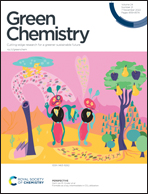A sustainable and profitable biorefinery strategy for efficiently converting lignocellulose to furfural, glucose and phenolic compounds†
Abstract
The sustainability and profitability of biorefineries are based on efficient utilization of all components of lignocellulosic biomass. However, the resistance of the lignocellulosic structure and the differences in the physicochemical properties of its main components are typical challenges for most lignocellulosic fractionation approaches. Here, we demonstrate a fractionation strategy that is able to efficiently fractionate the whole lignocellulosic component and convert it into a range of valuable products. The aim of our method is to maintain the quality of lignin components by adding isopropanol, while formic acid and molten salt hydrate (LiCl·3H2O) promote the dissolution of hemicellulose and lignin. Subsequently, the as-obtained cellulose is readily saccharified due to the invasion of the dense crystal structure, and enzymatic hydrolysis yields 728.3 mg g−1 glucose. After simple separation, 75.6 mol% furfural was produced from hemicellulose in the LiCl·H2O/γ-valerolactone (GVL) biphasic system and 75.7 wt% phenolic mono-/oligomers were produced from lignin hydrolyzed in formic acid/isopropanol(aq.). Attributed to this rational design, the techno-economic analysis predicts a revenue of 122.66 USD by processing 100 kg of waste bamboo using the above developed approach. In this process, all solvents participate in both fractionation and catalytic conversion and are allowed to be recycled, which is in line with the principles of green chemistry.



 Please wait while we load your content...
Please wait while we load your content...